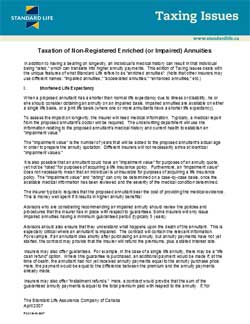Annuity Taxation
Annuity Tax Rules and Information

How Are Annuities Taxed in Canada?
In Canada, both registered and non-registered annuities are subject to taxation, but they are taxed differently.
Income received from a registered annuity is 100% taxable to the policyholder in the year that it is received. On the other hand, only a portion of the income received from a non-registered annuity is taxable to the policyholder. The income received from a non-registered annuity can have prescribed or non-prescribed (accrual) tax treatment.
Portion of Annuity Payment Subject To Tax
- Registered / Pension Funds
- Non-Registered Funds
For annuities that are purchased with Registered or Pension funds, the income from the annuity is 100% taxable in the year that it is received.
For annuities that are purchased with Non-Registered funds, only the interest portion of the payment is taxable. In other words, only a portion of the payment is taxable in the year that it is received. Non-Registered annuities can either have prescribed or non-prescribed (accrual) taxation.
Prescribed & Non-Prescribed Annuities
- Non-Prescribed Annuities
- Prescribed Annuities
- The annuity must be non-registered
- The annuity may be a Single Life, Joint and Survivor Life or Term Certain Annuity
- Guarantee of payments may not exceed the annuitant’s 91st birthday
- Payments must commence no later than December 31st of the year after the purchase of the annuity
- For Term Certain Annuities, the owner and payee must be the same person
- For Life Annuities, the annuitant, owner and payee must be the same person
- The purchaser/annuitant must be an individual (not a corporation) or a specified trust
- Payments cannot be indexed
- How Are Annuities Taxed?
- Registered vs Non-Registered Taxation
- Prescribed Taxation
- Non-Prescribed (Accrual) Taxation
- Level Taxation
- Taxation During the Deferral Period
- Withholding Tax
- Mandatory Withholding Tax
- Optional Withholding Tax
- Taxation of Non-Residents
- Income Splitting
- Pension Income Tax Credit
- Avoiding OAS Clawback
- Potential Creditor Protection
Payments from a non-prescribed annuity are a blend of interest and capital. The interest element is taxed as it accrues; therefore the taxation will be higher in the early years of the annuity and decrease over the life of the contract as the capital is paid out.
Payments from a prescribed annuity are treated as a level blend of interest and capital. The interest element is taxed on a level basis spread out over the life of the contract.
An annuity must qualify for prescribed taxation when the following partial list of conditions are met:



 Annuity Tax Brochure (Sun Life)
Annuity Tax Brochure (Sun Life) Annuity Tax Brochure (Standard Life)
Annuity Tax Brochure (Standard Life)